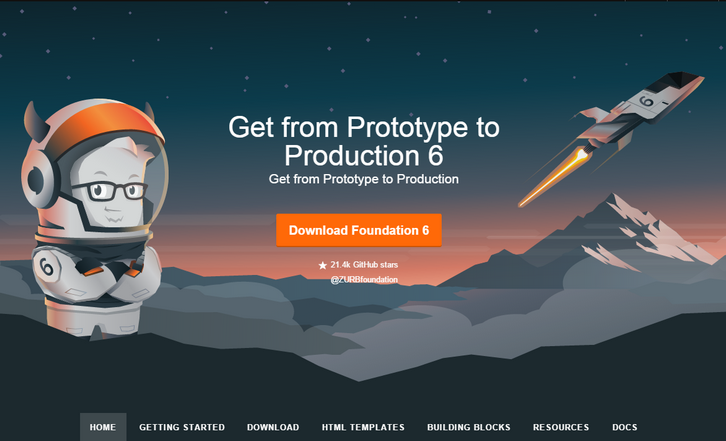Hugo is a static HTML and CSS website generator written in Go. It is optimized for speed, easy use and configurability. Hugo takes a directory with content and templates and renders them into a full HTML website. Hugo relies on Markdown files with front matter for meta data. And you can run Hugo from any directory. This works well for shared hosts and other systems where you don’t have a privileged account.
Hugo renders a typical website of moderate size in a fraction of a second. A good rule of thumb is that each piece of content renders in around 1 millisecond. Hugo is designed to work well for any kind of website including blogs, tumbles and docs.

Requirements: –
Demo: http://gohugo.io/
License: Apache 2.0 License
Phoenix framework is a productive web framework that does not compromise speed and maintainability. Phoenix brings back the simplicity and joy in writing modern web applications by mixing tried and true technologies with a fresh breeze of functional ideas. You can create rich, interactive experiences across browsers, native mobile apps, and embedded devices with our real-time streaming technology called Channels. Phoenix leverages the Erlang VM ability to handle millions of connections alongside Elixir’s beautiful syntax and productive tooling for building fault-tolerant systems.

Requirements: –
Demo: http://www.phoenixframework.org/
License: MIT License
Material is a graphics and animation framework for Google’s Material Design. It is designed to allow the creativity of others to easily be expressed. It includes Fully Configurable UI Components, Base Material Layers & Material Views To Create New UI Components, Side Navigation View Controller, Navigation Bar View, Material Buttons, Material Card Views, Camera / Video , Extension With Extensive Functionality, Layout Library To Simplify AutoLayout, Animation Extension To Create Intricate Animations, Complete Material Color Library and Example Projects.

Requirements: Swift
Demo: https://github.com/CosmicMind/Material
License: License Free
You can build your UI Toolkit with Fabricator. Fabricator is built on Node.js, a platform for building fast, scalable network applications. There are pre-built installers for each platform. You can also install with Homebrew via brew install node. You can organize your design system the way you want. Components, Structures, Elements, Atoms, Molecules, whatever – the taxonomy is up to you.
Generate a style guide from your toolkit code. Write documentation in markdown to make your toolkit easy for other developers to use. Uses gulp.js as a super-fast, highly-optimized build system to compress images, CSS, and JavaScript. Highly-portable local development environment with Handlebars and BrowserSync built-in for a fast, efficient workflow.

Requirements: –
Demo: http://fbrctr.github.io/
License: MIT License
At The New York Times, their development teams have been adopting the Go programming language over the last three years to build better back-end services. They use Go for a wide variety of tasks, but the most common use throughout the company is for building JSON APIs. As they started building more and more APIs, the pains of microservices started to become apparent.
Gizmo, is open source. Gizmo offers four packages to help developers quickly configure and build microservice APIs and pubsub daemons. The config package provides a set of common, composable structs for working with tools common to technology currently at The New York Times: MySQL, MongoDB, Oracle, AWS (SNS, SQS, S3), Kafka, Gorilla’s securecookie, Gizmo Servers.

Requirements: –
Demo: https://github.com/nytimes/gizmo
License: Apache License
Senna.js is a blazing-fast single page application engine that provides several low-level APIs that allows you to build modern web-based applications with only ~8 KB of JavaScript without any dependency. When using a single page app, sending a link to a friend should get them where we were. More than that, a search engine spider should be able to index that same content.
Forget hashbangs (#!), by using HTML5’s History API we can manipulate the user’s browser session history in JavaScript using pushState, replaceState and the popstate event. That way you can use browser’s back/forward buttons again. When some content is requested, it indicates to the user that something is happening. You can also define different kinds of CSS animations to use during state transitions. Once you load a certain surface this content can be cached in memory and be retrieved later on without any additional request.

Requirements: –
Demo: http://sennajs.com/
License: BSD License
Toshi is a complete implementation of the Bitcoin protocol, written in Ruby and backed by PostgreSQL. It provides a RESTful API that is ideal for building scalable web applications or analyzing blockchain data.
Toshi is designed to be fully compatible with Bitcoin Core. It performs complete transaction and block validation, and passes 100% of TheBlueMatt’s regression test suite. For much of the core protocol logic, Toshi makes use of the bitcoin-ruby library written and maintained by Julian Langschaedel.
Toshi was built at Coinbase, with the goal of replacing our core Bitcoin network infrastructure in the near future. It is currently in beta, and not recommended for production use until it has received sufficient testing from the Bitcoin community.

Requirements: bitcoin-ruby library
Demo: https://toshi.io/
License: MIT License
Layers CSS is Lightweight. Unobtrusive. Style-agnostic. Build your look on the web, not Twitter’s – and build it fluid. Layers CSS is a CSS framework aimed for practical use cases. It comes with a small footprint and zero bullshit.
- Normalizations & sensible defaults
- Fluid grid + progressively enhanced columns
- Preserves native form styles by default
- No px definitions
- No colors, no borders, no rounded corners
- No dependencies

Requirements: –
Demo: http://eiskis.net/layers/
License: MIT License
jQuery.my is a lightweight jQuery plugin for complex two-way data binding in real time. It’s a plugin for real time two-way data binding. It mutates object given as data source, reflecting interactions between user and UI. jQuery.my recognizes both standard HTML controls and complex composites created using rich ui plugins. Controls built with jQuery UI, Select2, CodeMirror, Ace, Redactor, CLeditor, jQuery Mobile are supported out of the box.
jQuery.my provides comprehensive validation, conditional formatting, complex dependencies, runtime form structure manipulation. $.my forms can run nested, each jQuery.my instance can be a composite control for parent form. Syntax of $.my manifest is very simple, lean and unobtrusive. There exist specialized in-browser IDE for $.my apps authoring. This IDE is a built-in component of cloudwall.me system.

Requirements: jQuery Framework
Demo: http://jquerymy.com/
License: License Free
Foundation for Sites 6 has been designed to get your project from prototype to production more efficiently than ever before! It includes a wide range of modular and flexible components that are easily styled. These versatile and lightweight building blocks make it easy to bring your ideas to life. Total filesize of every component and class now weighs in at 60KB CSS & 84KB JS, with plenty of room to make them even smaller when selectively removing unused components.
All code snippets come with ARIA attributes and roles along with instructions on how to properly use these components. This helps ensure that every website built on Foundation 6 can be used anywhere, on any device, by anyone. The base styles act as a coded wireframe rather than a final design. Simpler CSS styles allow you to more easily modify them to fit your brand.

Requirements: –
Demo: http://foundation.zurb.com/sites.html
License: MIT License













